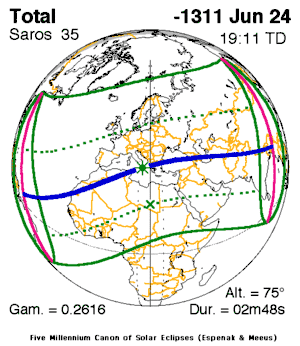Mursili's eclipse



The solar eclipse mentioned in a text dating to the reign of Mursili II could be of great importance for the absolute chronology of the Hittite Empire within the chronology of the Ancient Near East. The text records that in the tenth year of Mursili's reign, "the Sun gave a sign" (istanus sakiyahta), just as the king was about to launch a campaign against the Kingdom of Azzi-Hayasa in north-eastern Anatolia.[1]
The reference in the annals was first interpreted as describing an eclipse by Emil Forrer (1926),[2] Schorr (1928) identified it as the eclipse the of 13 March 1335 BC, visible as annular in Anatolia in the afternoon.[3] It is now more commonly identified as the one of 24 June 1312, which was visible in totality in northern Anatolia in the afternoon.[4] Paul Åström (1993) proposes the alternative date of 13 April 1308, which would have been visible as partial eclipse at sunrise. Peter J. Huber has suggested a date of 8 January 1339 BC. [5]
1312 eclipse
The 1312 eclipse occurred over northern Anatolia in the early afternoon, and its effects would have been quite spectacular for Mursili and his men on campaign:
- 24 June 1312 BC, total eclipse, maximum at 10:44 UTC, 38°12′N 13°42′E / 38.2°N 13.7°E (Sicily) and lasted 2 min 48 sec, some stated as it occurred inside the Ionian Sea at 17 E.
Areas that were inside the maximum eclipse included the islands that are now Barlavento in Cape Verde, the Moorish lands (comprising modern day Mauritania, Western Sahara, Morocco and Algeria), Tunisia (then inner Africa), Greece, the Caucasus region, Persia (now Iran), in the area of the present-day Iranian-Turkmeni border, present-day Afghanistan and Pakistan and a part of the north of India.
The eclipse started off in modern-day Brazil in South America and finished in what is now Myanmar (also known as Burma).
The 1312 date would imply that Mursili began his reign in either 1322 or 1321 BC. This date would be roughly that usually proposed for the death of Tutankhamun. It is known that Suppiluliuma I was besieging Carchemish when he received a letter from the widow of a Pharaoh (who is called Dakhamunzu in the annals). Suppiluliuma died shortly thereafter and his successor was Mursili II (whose brother would have been Prince Zannanza sent to Egypt where he died). Thus this appears to be a chronological anchor. However, there are other views, asserting for example that the dead Pharaoh was Akhenaten or that Tutankhamun died later.
1308 eclipse
In contrast, the 1308 eclipse was annular, and began very early in the morning over Arabia (and only penumbral over Anatolia and Syria), reaching its height over Central Asia:
- 13 April 1308 BC, annular eclipse (94.8%), maximum at 04:16 UTC, 44°54′N 85°42′E / 44.9°N 85.7°E (Tian Shan) and lasted 4 min 40 sec.
Other areas that had inside the band of the annular eclipse included the Indus Delta and parts of Siberia including the New Siberian Islands. The maximum eclipse ended at sunset over the Beaufort Sea along with the Bering Sea and the westernmost portion of Alaska with the west of the Aleutian Islands. The eclipse covered much of Asia except for the southwesternmost portions and the southeastern islands, one of the islands that was near the edge of the eclipse was Honshū, Japan.
See also
References
- ↑ KUB XIV 4.24: [ma-a-an I-NA KUR A]zi-ma i-ia-ah-at nu dUTU-us sa-ki-ya-ah-ta "[When] I marched [to the land of A]zzi, the Sungod gave a sign." Theo P. J. Van Den Hout, The Purity of Kingship: An Edition of CTH 569 and Related Hittite Oracle Inquiries of Tutẖaliya (1998), 42f.
- ↑ E. Forrer, Forschungen II 1.1 "Astronomische Festlegung des Soppiluljomas, Morsilis und Amenophis IV." (1926) KUB XIV,4 (= CTH 70).
- ↑ Astronomische Abhandlungen 8-9 (1929), p. 16. Mitteilungen des Instituts für Orientforschung 6 (1958), 188.
- ↑ Bryce (1998)
- ↑ Peter J. Huber, The Solar Omen of Muršili II, Journal of the American Oriental Society, vol. 121, no. 4, pp. 640-644, (Oct. - Dec., 2001)
Further reading
- Paul Astrom, 'The Omen of the Sun in the Tenth Year of the Reign of Mursilis II', in Horizons and Styles: Studies in Early Art and Archaeology in Honour of Professor Homer L. Thomas, (1993)
- Trevor R. Bryce, The Kingdom of the Hittites, Clarendon Oxford University Press, (1998)
External links
- path map (NASA)
